Gardening where summers sizzle brings unique challenges. Soil dries faster. Plants wilt quicker. But what if you could grow more with less space while beating the heat? That’s where Mel Bartholomew’s innovative planting method shines. His approach lets you create productive, organized beds that conserve water and simplify maintenance.
The secret lies in dividing growing areas into manageable grids. This system helps you maximize yields without wasting resources. You’ll spend less time weeding and watering while getting better results from your favorite vegetables and herbs.
This guide walks through building raised beds that protect plants from scorching temperatures. Discover companion planting strategies that provide natural shade. Learn timing tricks for succession planting across seasons. We’ll also share soil mix recipes that retain moisture during dry spells.
Whether you’re new to compact growing or want to upgrade existing beds, these techniques help your green space thrive. Get ready to transform how you plant, nurture, and harvest – one perfectly planned square at a time.
Understanding Zone 9 Gardening and Its Unique Challenges
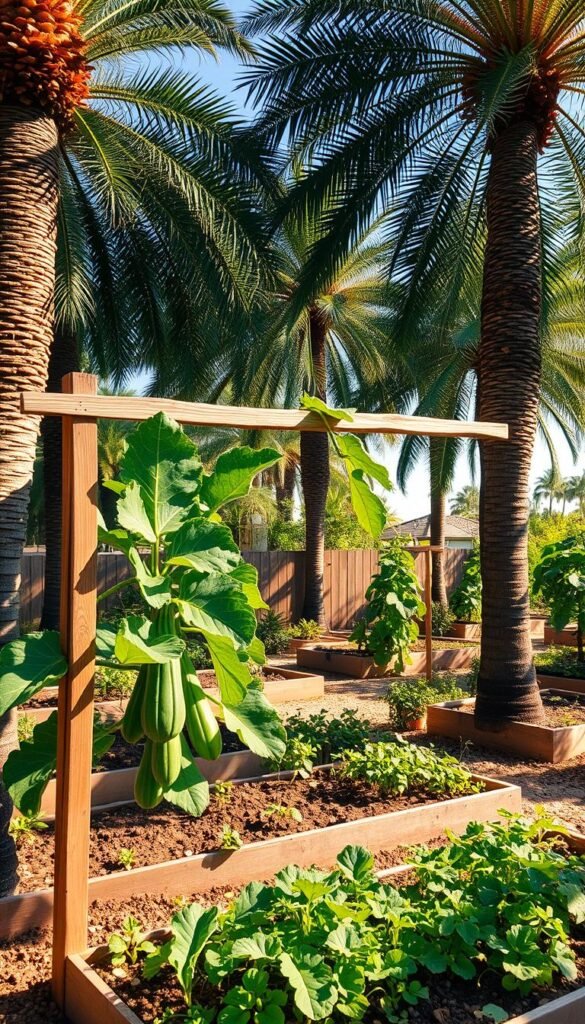
Growing plants in areas with blazing summers requires smart planning. Temperatures often stay above 90°F for weeks, and drying winds pull moisture from leaves and soil. Let’s explore how to work with these conditions rather than against them.
Overview of Climate Conditions
This region experiences over 200 sunny days yearly, with summer heatwaves lasting 10+ days. Nighttime temps rarely drop below 75°F, stressing plants that need cool recovery periods. Coastal zones face salty breezes, while inland areas battle intense UV exposure.
Key Considerations for Heat Management
Three factors dominate here: rapid evaporation, sunburned foliage, and exhausted soil nutrients. Your garden thrives when you balance full sun access with afternoon shade options. Observe where shadows fall naturally during peak sunlight hours.
| Challenge | Plant Impact | Solution |
|---|---|---|
| Prolonged Heat | Stunted growth | Shade cloth after 1 PM |
| Dry Winds | Leaf dehydration | Windbreak fencing |
| Soil Overheating | Root damage | Mulch layers |
Track your local weather patterns using free apps. Notice when monsoon rains arrive or heat domes form. This helps schedule planting times and protective measures effectively.
Benefits of Square Foot Gardening in Hot Climates
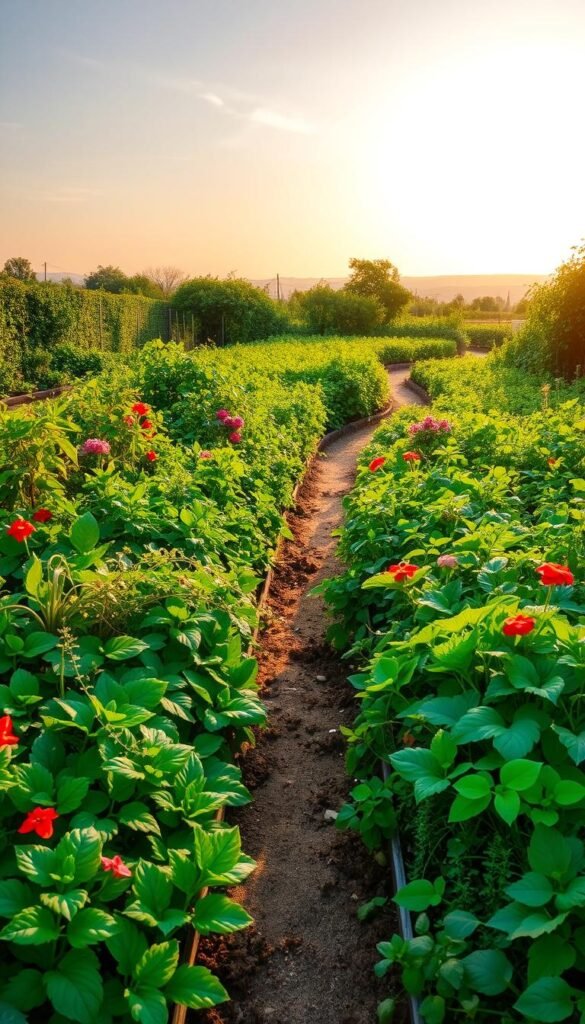
Smart growing systems shine in areas where thermometers climb. The grid-based approach lets you pack more greenery into limited areas while simplifying care routines. Instead of fighting nature, you work with it through intelligent design.
Space Maximization Made Simple
Dividing beds into foot-by-foot sections creates clear planting zones. You might grow 16 carrot seedlings in one square while reserving another for a single eggplant. This prevents overcrowding and ensures each plant gets exactly what it needs.
Less Work, More Results
Three advantages make this method ideal for warm regions:
- Soil stays moist longer due to dense plant coverage
- Weeds struggle to establish in occupied spaces
- Targeted watering reduces evaporation waste
Imagine harvesting basil and tomatoes from the same bed without battling invasive grasses. The structured layout helps roots stay cool while leaves create natural shade networks. You’ll spend minutes weekly maintaining what used to take hours.
Real-world examples prove the concept. One gardener reported 80% less water use after switching to gridded beds. Another tripled their pepper yield using vertical supports within the squares. These successes show how organized planting conquers climate challenges.
How to Build Your Square Foot Garden Layout
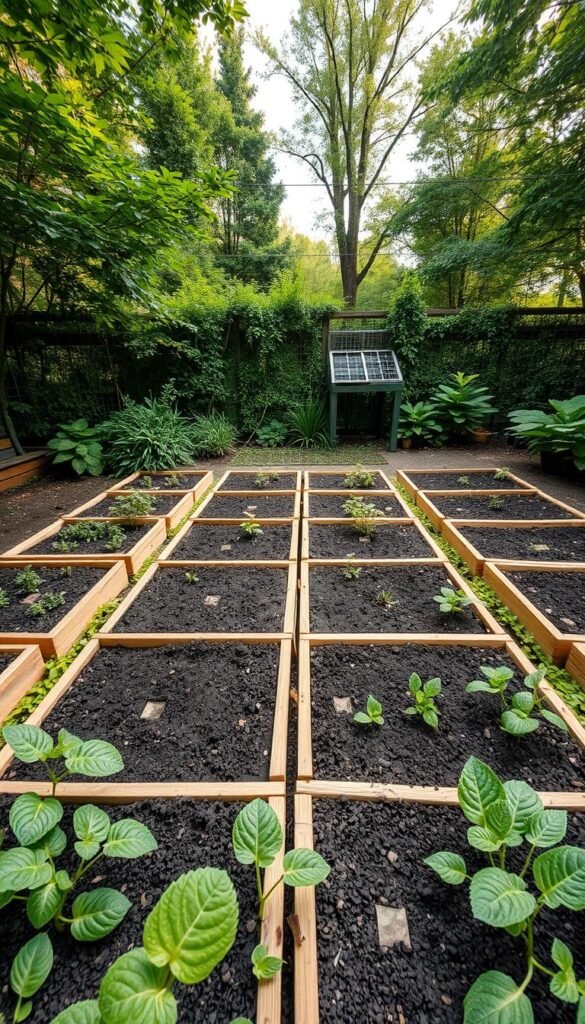
A well-structured garden bed can transform your growing experience. Let’s break down the process into two critical phases: building a sturdy foundation and organizing your planting zones.
Designing a Raised Bed Structure
Start by choosing durable materials. Cedar resists rot naturally, while pressure-treated lumber offers budget-friendly longevity. Avoid woods that leach chemicals into soil.
Build a 4×4 frame using these steps:
- Cut boards to 4-foot lengths
- Assemble with corrosion-resistant screws
- Position in full sun with north-south orientation
Depth matters for root development. Shallow 6-inch beds work for herbs. Deeper 12-inch setups suit carrots or potatoes. Consider planning your layout around crop needs before finalizing dimensions.
Creating an Effective Grid System
Divide your bed using weatherproof materials. Wooden yardsticks nailed across the frame create visible squares. For flexible options, try nylon string or thin PVC strips.
Follow this spacing guide:
| Plant Size | Quantity per Square | Examples |
|---|---|---|
| Large | 1 | Tomatoes, Peppers |
| Medium | 4 | Lettuce, Kale |
| Small | 16 | Radishes, Carrots |
Concrete planter blocks make adjustable grids for changing crops. Label each section with paint or tags to track your plant per square arrangements. This system keeps roots organized and simplifies maintenance.
Soil Preparation and Composting for Heat Resilience
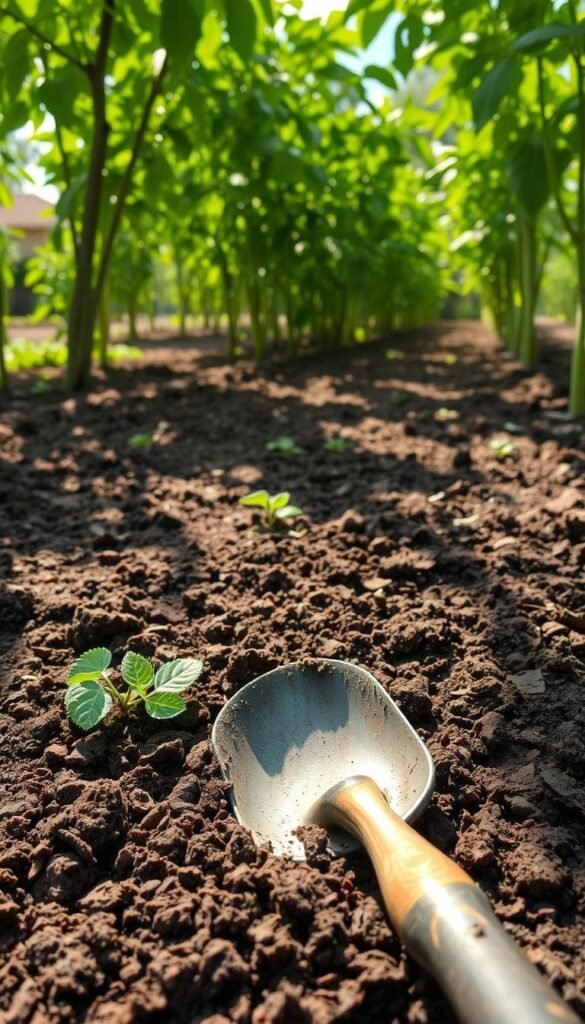
Healthy soil acts like a sponge during heatwaves. When temperatures soar, roots need steady access to water and nutrients. Start by blending compost into your growing medium – it’s the ultimate defense against baked earth.
Building a Moisture-Rich Foundation
Mix one-third compost with existing soil for optimal results. This ratio creates air pockets while boosting water retention. Test your blend by squeezing a handful – it should hold shape briefly before crumbling.
| Component | Benefit | Ideal Amount |
|---|---|---|
| Compost | Retains moisture | 30-40% |
| Vermiculite | Improves aeration | 20% |
| Peat Moss | Prevents compaction | 10-15% |
Feeding the Underground Ecosystem
Turn your soil monthly with a broadfork to invite oxygen-loving microbes. These tiny workers break down organic matter faster, creating natural fertilizers. Add worm castings every 60 days to maintain nutrient levels.
Struggling plants recover quicker in active soil. If leaves wilt despite proper watering, check for dense clay layers. A simple pH test kit reveals when to add lime or sulfur for balance.
Watering Techniques for Extreme Heat Conditions
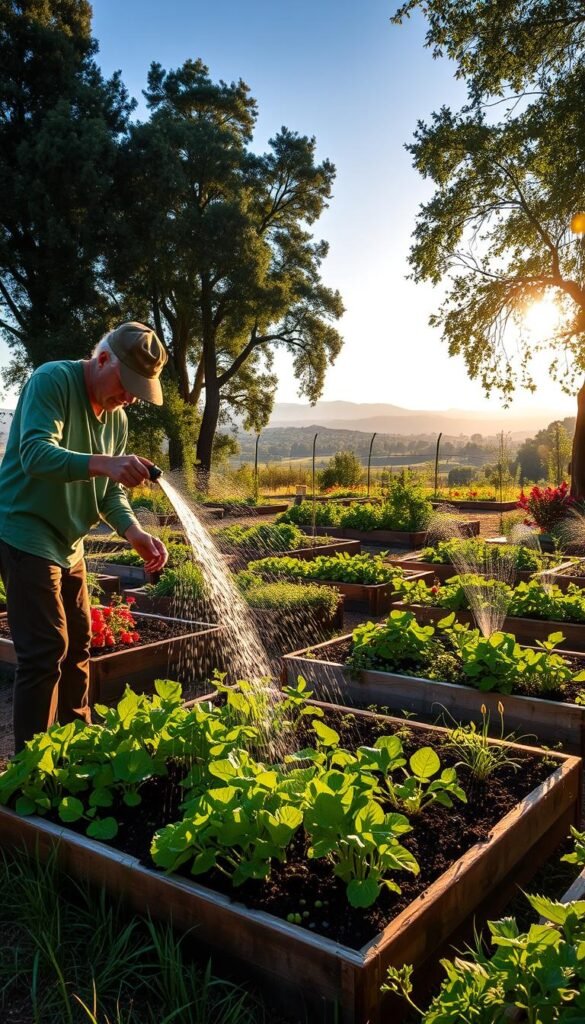
Keeping plants hydrated during scorching days requires smart timing and tools. When temperatures soar, every drop counts. Proper techniques ensure roots get what they need without wasting resources.
Optimal Morning Watering Strategies
Water before 9 AM to beat the heat. Cooler soil absorbs moisture better, and leaves dry faster, reducing disease risks. Use a watering wand with a gentle spray head to avoid soil disruption. For seedlings, try a small container with holes in the base – it delivers precise amounts directly to roots.
Check soil moisture first. Push your finger an inch deep. If it feels dry, water thoroughly. For seeds, mist the surface lightly twice daily until sprouts appear. This prevents washing away delicate seedlings while keeping the top layer damp.
| Method | Best For | Water Saved |
|---|---|---|
| Watering Wand | Established Plants | 25% |
| Container Drip | Seedlings | 40% |
| Soaker Hose | Row Crops | 30% |
Focus water at the plant base, not leaves. This targets roots where hydration matters most. Adjust your approach as plants grow – mature tomatoes need deeper soaking than new basil starts. Consistent morning routines help your garden thrive even during heatwaves.
Implementing Shade Cloth and Wind Blocks for Plant Protection
Protecting your greenery from intense sun and drying gusts keeps them productive during harsh weather. Strategic barriers help maintain ideal growing conditions while letting your crops thrive. These solutions work together to filter harsh elements without blocking essential resources.
How to Use Shade Cloth Effectively
Choose 30-50% UV-blocking fabric for most vegetables. Drape it over metal hoops or wooden frames positioned 2-3 feet above plants. Secure edges with binder clips or bungee cords for easy removal during cooler spells.
Morning light matters most for growth. Position covers to block afternoon rays while allowing dawn illumination. Check coverage by observing shadow patterns at different times.
Setting Up Wind Barriers in Your Garden
Create natural screens using hay bales or lattice panels on your plot’s windward side. Space barriers 4-5 feet apart to slow gusts without creating turbulence. Porous materials like shade netting work better than solid walls – they reduce wind speed by 60% while letting air circulate.
| Material | Effectiveness | Cost |
|---|---|---|
| Hay Bales | Moderate | $ |
| Plywood Screens | High | $$ |
| Shrubs | Excellent | $$$ |
Rotate barriers seasonally as wind patterns shift. Pair them with your shade structures to create microclimates. This combo can lower soil temps by 8°F and cut water needs by a third during heatwaves.
Monitor plant responses weekly. Yellowing leaves might signal too much shade. Adjust cloth height or barrier placement until you see steady growth and vibrant colors.
Optimal Planting Strategies in a Square Foot Garden
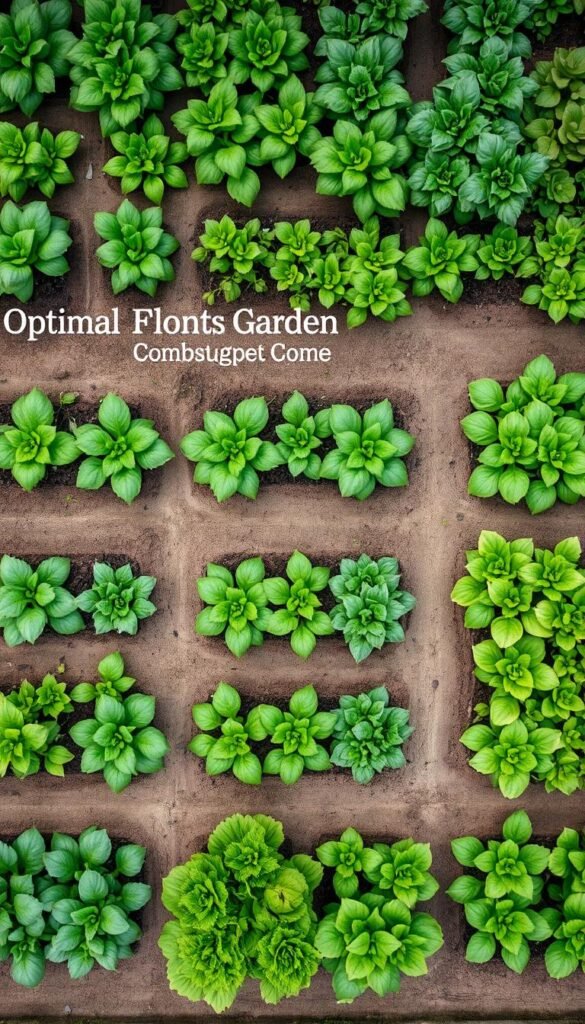
Smart spacing turns small plots into powerhouse producers. Proper arrangements let roots breathe while leaves capture sunlight efficiently. Let’s explore how to pack your squares for maximum harvests without overcrowding.
Mastering Plant Placement
Group crops by their mature size to prevent resource battles. Large plants hog water and nutrients if placed too close to smaller neighbors. Follow these guidelines to keep everyone thriving:
| Growth Stage | Plants per Square | Top Picks |
|---|---|---|
| Bushy & Tall | 1 | Tomatoes, Eggplants |
| Medium Spread | 4 | Swiss Chard, Kale |
| Compact Roots | 16 | Radishes, Green Onions |
Swiss chard works beautifully beside vertical growers like beans. Its colorful leaves fill gaps without blocking sunlight. Pair it with root vegetables like carrots for efficient space use – they’ll grow at different depths.
Sketch your grid first. Grab graph paper and pencil to map each square. Label sections with crop names and planting dates. This visual plan helps rotate plants seasonally and track growth patterns.
Leave breathing room between leafy greens. Overcrowded lettuce becomes bitter and prone to disease. For vining plants like cucumbers, train them upward with trellises to save ground space.
Choosing Heat-Tolerant and Drought-Resistant Crops
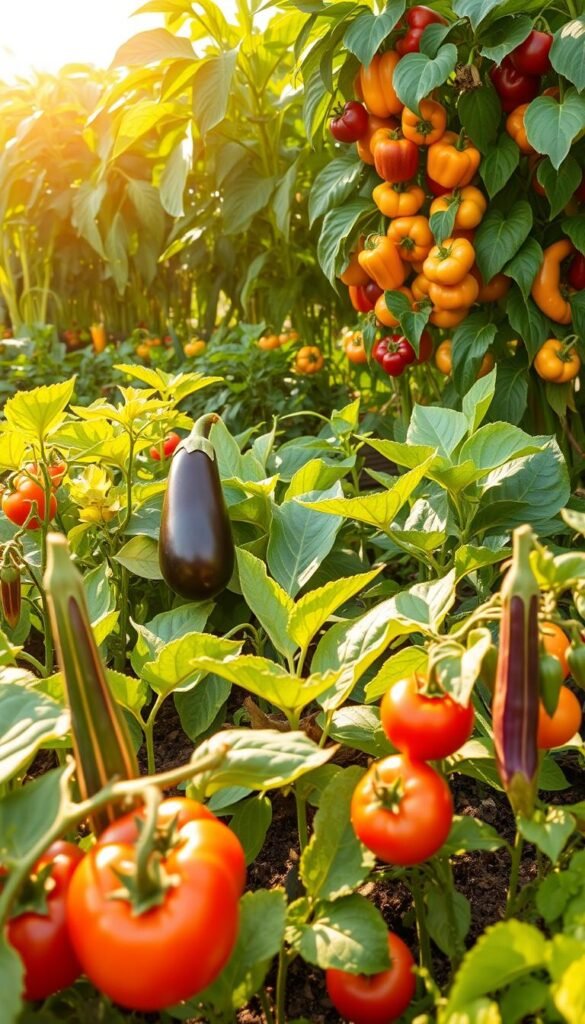
Plant selection becomes your secret weapon against relentless summer conditions. Some vegetables naturally handle scorching days better than others, requiring less babysitting while delivering impressive harvests. Focus on varieties bred to thrive when others wilt.
Summer Survivors for Your Plot
Look for these champions at your local nursery or seed catalog. Tomatoes like ‘Solar Fire’ and ‘Heatmaster’ set fruit even at 90°F. Eggplant varieties such as ‘Florida High Bush’ develop thick skins that lock in moisture. Vining cucumbers (‘Suyo Long’) and bush beans (‘Bronco’) handle dry spells better than traditional types.
| Crop | Heat Tolerance | Water Needs |
|---|---|---|
| Tomatoes | High (90°F+) | Moderate |
| Eggplant | Very High | Low |
| Cucumbers | Medium-High | Regular |
Always check plant tags or descriptions for phrases like “heat-set” or “drought-resistant”. Pair deep-rooted crops with shallow feeders to maximize space. A square might combine okra (deep) with basil (shallow) – they’ll share water without competing.
Mixing crop types creates natural microclimates. Tall plants shield lower-growing varieties from afternoon sun. This approach mirrors desert gardening strategies where plants work together to beat the heat. You’ll notice less leaf scorch and more consistent yields throughout summer.
Zone 9 Gardening Essentials: Managing Heat in a Square Foot Garden
Effective heat control starts with how you position and nurture each plant. Combining smart layouts with protective measures helps your green space flourish even during relentless summers. Let’s explore how to blend these strategies seamlessly.
Smart Integration Techniques
Time-sensitive care makes all the difference. Water seeds early in the morning when soil absorbs moisture best. For transplants, wait until evening temperatures drop below 85°F to reduce shock. Pair this schedule with these tactics:
- Install shade cloth over tender seedlings during peak afternoon hours
- Position tall crops like corn or sunflowers to cast natural shadows
- Rotate containers to balance sun exposure for potted herbs
Staggered watering keeps roots hydrated without oversaturation. Use a zigzag pattern across your grid – hydrate one row deeply while lightly misting the next. This approach prevents waterlogging and encourages stronger root systems.
| Technique | Implementation | Benefit |
|---|---|---|
| Shade Cloth | Drape 40% UV-block fabric at noon | Reduces leaf scorch |
| Companion Planting | Grow basil beside tomatoes | Natural pest control + shade |
| Mulch Layers | Apply straw around squash | Keeps soil 10°F cooler |
Monitor your plants grow daily. If leaves curl or flowers drop, adjust their placement immediately. Swap struggling starters with hardier varieties like okra or sweet potatoes. Remember – flexibility beats rigid plans when thermometers spike.
With thoughtful adjustments, your garden becomes a heat-defying oasis. Prioritize air circulation, moisture retention, and strategic shading. These steps ensure every square foot thrives, no matter how high the mercury climbs.
Incorporating Vertical Gardening to Maximize Space
Turn empty airspace into productive growing zones with simple structures. Vertical techniques let you grow twice as many crops without expanding your plot’s footprint. By training plants upward, you’ll create natural cooling systems and simplify harvesting.
Harnessing Trellis Power
Install sturdy supports before planting vining varieties. Use cattle panels or bamboo poles for heavy producers like tomatoes. For lighter plants like peas, try nylon netting secured to wooden posts. Position trellises on the north side of beds to avoid shading smaller crops.
Follow these proven tips for success:
- Anchor supports 12 inches deep to withstand summer storms
- Train stems gently with soft plant ties as they grow
- Prune lower leaves to improve airflow and reduce disease
| Crop | Support Type | Yield Boost |
|---|---|---|
| Cucumbers | A-frame trellis | 40% more fruit |
| Pole Beans | Tepee structure | Double harvests |
| Melons | Slanted netting | 30% larger size |
Vertical gardening keeps leaves dry and roots cool. Your square foot garden stays organized while producing basketfuls of fresh food. Try pairing scarlet runner beans with morning glories – you’ll get edible pods and gorgeous flowers sharing one trellis.
Maintenance Practices for Weeds and Moisture Control
Consistent care keeps unwanted plants from stealing nutrients and water. Tackle weeds early – they compete fiercely with your crops in tight spaces. Check beds weekly, focusing on areas between mature plants and seedling clusters.
Try these low-impact removal methods:
- Snip small invaders with nail scissors near delicate roots
- Twist broadleaf weeds clockwise before pulling gently
- Spot-treat persistent growth using vinegar spray (1 part vinegar to 3 parts water)
Mulch acts as your secret weapon. Spread straw or shredded leaves 2 inches thick around established plants. This barrier blocks sunlight from weed seeds while locking in ground moisture. Refresh layers monthly as materials break down.
| Tool | Best Use | Efficiency |
|---|---|---|
| Hori-Hori Knife | Deep-rooted weeds | 90% removal |
| Hand Fork | Surface-level growth | Quick cleanup |
| Collinear Hoe | Between tight spaces | Prevents soil disturbance |
Test soil hydration daily. Push a chopstick into the ground – if it comes out clean, water deeply. For container plants, lift pots to check weight. Light containers need immediate attention.
Morning routines make maintenance manageable. Spend 10 minutes daily inspecting leaves and soil. This habit catches problems early, letting your green friends thrive with minimal fuss.
Seasonal Adjustments for a Successful Garden
Your garden thrives when you sync with nature’s rhythm. As temperatures shift, small tweaks keep plants productive. Learn to dance between summer’s intensity and autumn’s gentler days without missing a beat.
Summer Heat Strategies
Beat the heat with smart timing. Water deeply before 8 AM or after 6 PM to reduce evaporation. Swap thirsty crops like spinach for sturdy okra or Malabar spinach. These leafy greens handle 90°F+ days without bolting.
Try these sun-smart upgrades:
- Install 40% shade cloth over lettuce beds from 11 AM–3 PM
- Spread light-colored mulch to reflect sunlight away from roots
- Switch to drought-tolerant herbs like rosemary and oregano
Transitioning to Cooler Seasons
When nights dip below 70°F, start your fall lineup. Sow seeds for broccoli and carrots 8-10 weeks before your first frost date. Protect young plants with row covers during lingering warm spells.
| Summer Task | Fall Prep | Timing Tip |
|---|---|---|
| Harvest peppers | Plant kale | 6 weeks before frost |
| Remove spent vines | Add compost | After Labor Day |
| Prune tomatoes | Start garlic | Mid-October |
Rotate crops to refresh soil nutrients. Where tomatoes grew, plant nitrogen-fixing peas. This natural reset keeps your garden thriving year-round. Watch weather apps for perfect planting windows – cool mornings with afternoon sun boost seedling success.
Advanced Techniques for Sustaining Garden Health
Transform your garden into a self-sustaining ecosystem with clever plant partnerships and soil science. These methods boost resilience while cutting your workload – especially when temperatures climb.
Companion Planting Benefits
Strategic pairings create natural pest barriers and nutrient-sharing networks. Broccoli thrives when flanked by onions – their strong scents repel cabbage worms. Beets grow sweeter roots near leafy greens like chard, which shades soil and retains moisture.
Try these winning combinations:
- Potatoes with peas (legumes fix nitrogen)
- Carrots alongside rosemary (herb deters carrot flies)
- Basil beneath tomato cages (improves flavor)
Innovative Soil Amendment Practices
Revitalize tired earth with cutting-edge additives. Biochar increases water retention by 20% while hosting beneficial microbes. Crushed eggshells mixed into planting holes prevent blossom-end rot in peppers and tomatoes.
| Amendment | Benefit | Best For |
|---|---|---|
| Worm Castings | Slow-release nutrients | All crops |
| Kelp Meal | Stress resistance | Leafy greens |
| Compost Tea | Disease suppression | Seedlings |
Apply amendments during cooler evenings. Water thoroughly to activate their benefits. Rotate treatments monthly for balanced soil biology that withstands heat waves.
Final Reflections on Your Garden Journey
Your green space becomes a living classroom where every season teaches new lessons. Through smart layouts and heat-beating tactics, you’ve learned to make limited areas work harder. Each square foot now serves multiple purposes – growing food, creating shade, and conserving resources.
Remember how proper soil blends and timed watering kept roots thriving during droughts? Those techniques ensure your garden remains resilient year-round. Strategic shading and vertical growth turned challenges into advantages, proving small spaces can yield big results.
Every choice adds up. Companion planting reduced pests naturally. Seasonal swaps kept harvests coming. Trellised crops saved ground space while cooling the soil below. These thoughtful steps create a system where plants support each other – and you.
As you plan ahead, trust that each square foot contributes a lot to your success. What starts as a single bed often sparks bigger dreams. Maybe you’ll expand next season or try new drought-resistant varieties. Either way, your journey proves that careful planning and adaptability conquer even the toughest climates.
Keep celebrating small wins – that first ripe tomato, the herbs that survived a heatwave. Your garden isn’t just producing food; it’s growing confidence. And that’s the most valuable harvest of all.






